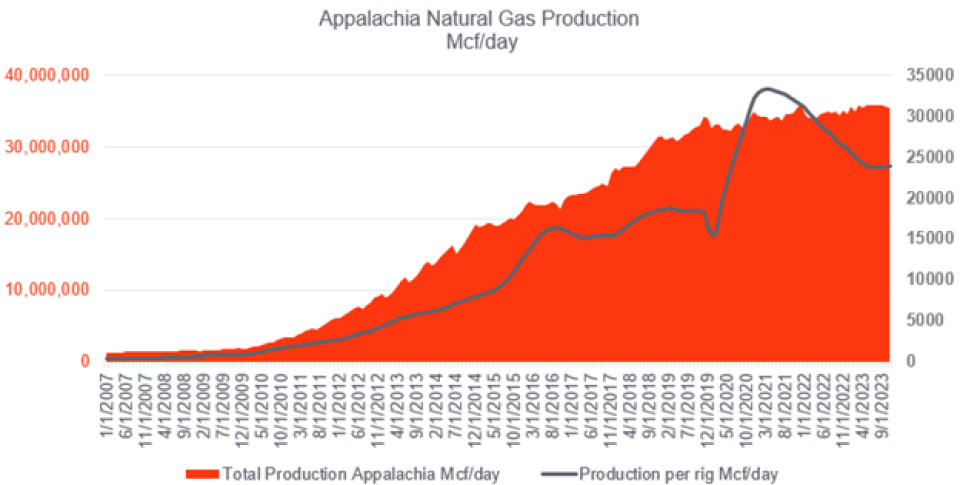Has Captive Appalachian Natural Gas Production Found an Outlet in the ARCH2 Hydrogen Hub?

Natural gas production out of Appalachia isn’t new; it is widely believed that the first intentional well in the U.S. was dug in New York over 200 years ago. However, since the start of the shale revolution, natural gas production out of Appalachia’s Marcellus and Utica plays has grown exponentially. The chart below shows that gas production in January 2010 averaged 1.9 Bcf per day (area chart left axis), according to EIA data. During that same month, production per drilling rig averaged just 1,012 Mcf/day (line chart right axis).

The years between 2010 and 2020 proved to be a decade of exponential growth for Appalachia in total volume produced and production per well, spurred by matching growth in infrastructure that brought that supply to thirsty energy markets that were reducing demand for coal. By December 2021, production had peaked, averaging 36 Bcf per day, with an average production per well of 32,641 Mcf/day.
Since then, production has stalled at 35 Bcf/day; production per well has dropped down to 23,868 Mcf/day, which is still twice the production per well of any other shale play (Haynesville -12,064/well); and producer interest in adding additional rigs has waned. The reason? It’s not because there isn’t any gas remaining in Appalachia, but rather the ability to get the abundant and economical fuel to a market. Current supply in the region already exceeds the intra-regional gas demand, and with no new greenfield interstate pipeline projects in the works, the easiest way to get Appalachia back into growth mode would be to find a significant intra-regional demand for natural gas.
This is where the Department of Energy’s (DOE) October 13 announcement of seven hydrogen hub locations comes into play. One of the seven announced is the Appalachian Regional Clean Hydrogen Hub (ARCH2), which secured $925 million of the $7 billion awarded. This multi-state partnership is comprised of West Virginia, Ohio, and Pennsylvania businesses and governments and led by Battelle, the largest independent applied science and technology organization in the world.
What does hydrogen have to do with natural gas production? Significant amounts of energy are required to produce hydrogen. Today, 85-95% of all hydrogen production in the U.S. is made by burning natural gas in order to turn steam into hydrogen (gray hydrogen). But that process, while the least expensive, also emits significant CO2 into the atmosphere.
Blue hydrogen takes this process a step further by capturing the CO2 and then permanently sequestering the CO2 underground via Carbon Capture Sequestration (CCS) technology. Widespread use of CCS doesn’t exist for the production of hydrogen but has been successful at capturing over 90% from other applications (one example is the Petra Nova project in south Texas). Economically, blue hydrogen production is the next in line to capture hydrogen production at scale, and at a significantly lower cost than green hydrogen produced from renewable power sources. This offers an advantage to Appalachia-based blue hydrogen over the next decade.
Appalachia boasts unique advantages such as excess natural gas feedstock, existing energy expertise, receptive geology for CCS, and robust infrastructure assets that could be utilized for the nascent hydrogen market. These advantages, paired with the work of industry stakeholders and DOE’s award to the ARCH2 hydrogen hub, have provided an opportunity to establish the region’s leadership role in the race to decarbonize.
Will it happen? Only time will tell. But something must give for a decarbonized economy to prosper: Either demand for energy must decline, or availability of another energy source must drastically increase – and at a price that is far lower than where it is currently is priced. My bet is that energy demand will not decline voluntarily, leaving us with the challenge of finding another energy source at a price that doesn’t lose the economic advantage we have today. One of those options with potential is the ARCH2 regional hydrogen hub in Appalachia.
